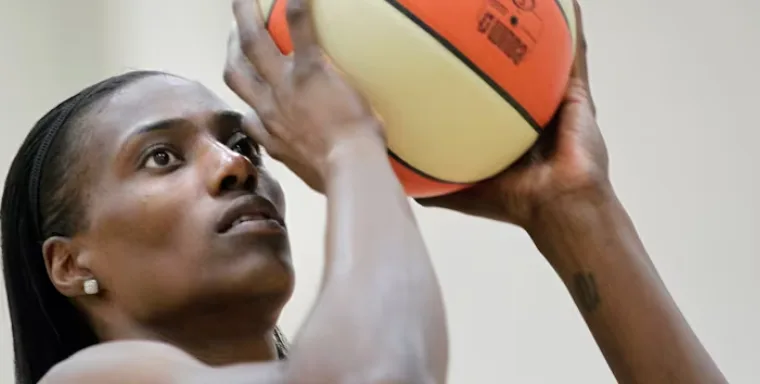There’s a certain texture to the history of the WNBA, a grit forged in the early days of commercial flights, minimal media coverage, and a collective fight for legitimacy. For legends like Sylvia Fowles, who retired in 2022 as one of the most dominant centers the game has ever seen, the league was built on an unspoken covenant of sacrifice. You played for the name on the front of the jersey, and in doing so, you lifted up the names on the back. In an exclusive and reflective interview, Fowles has now opened up about the palpable cultural evolution she witnesses in today’s WNBA, describing a modern landscape that feels distinctly different from her era, one increasingly driven by individuality and personal brand.
Fowles’s comments aren’t delivered with the bitterness of a typical “back in my day” critique. Instead, they carry the weight of thoughtful observation from a player who bridged two distinct eras of women’s basketball. Her perspective offers a rare, nuanced lens through which to view the league’s explosive growth, posing a critical question: as the WNBA rightly celebrates its soaring popularity and individual stardom, is it at risk of losing the cohesive, team-first DNA that ensured its survival?
Building a Legacy on Grit: The “Sylvia Fowles” Era
To understand Fowles’s viewpoint, one must first appreciate the environment in which she became a superstar. Drafted second overall in 2008 by the Chicago Sky, Fowles entered a league still fighting for its financial footing. Salaries were a fraction of what they are today, and off-season play overseas wasn’t a luxury it was a necessity for making a livable wage. This shared struggle created a unique bond among players. There was a pervasive sense that they were all in it together, a collective pushing the boulder of recognition uphill.
This mentality bled directly onto the court. Fowles’s game was the epitome of selfless dominance. A four-time Defensive Player of the Year and two-time champion with the Minnesota Lynx, her legacy was built on setting bone-rattling screens, commanding the paint with ferocious rebounding (she is the WNBA’s all-time leading rebounder), and scoring efficiently within the flow of the offense. Her 2017 MVP season with the Lynx was a masterclass in team-centric basketball, where her individual brilliance was the engine for a legendary squad that prioritized ball movement and defensive chemistry over isolation plays. Her era valued the wins and championships, often away from the highlight reels.
The New Wave: Empowerment, Branding, and the Individual
Contrast that with the modern WNBA, a league transformed. The influx of monumental talent from collegiate powerhouses like South Carolina and UConn, coupled with landmark Collective Bargaining Agreements (CBA) that have significantly increased salaries and improved benefits, has changed the player experience fundamentally. Today’s stars, such as A’ja Wilson, Breanna Stewart, and Caitlin Clark, are not just athletes; they are moguls-in-the-making.
They enter the league with massive social media followings, seven-figure endorsement deals from brands like Nike and Wilson Sporting Goods, and a clear understanding of their personal marketability. The off-season grind for survival has been replaced, for the top tier, by the business of brand management. This is a positive development a long-overdue correction that finally values women athletes as the stars they are. However, as Fowles astutely observes, this shift in focus inevitably influences on-court dynamics. The emphasis can tilt toward individual accolades, signature moves, and generating viral moments the very ingredients that fuel a personal brand in the digital age.
A Clash of Philosophies: Team Chemistry in the Spotlight
This isn’t to say today’s players are selfish; that’s a vast oversimplification. The 2023 Las Vegas Aces, for example, were an offensive juggernaut that played a beautiful, unselfish style on their way to a championship. However, the cultural ecosystem surrounding the players has undeniably changed. The constant external noise from social media, the intense scrutiny from a 24/7 news cycle, and the pressure to perform as an individual entity can sometimes create friction within the closed confines of a team locker room.
Fowles’s era operated with a certain insulation. The primary pressure was internal, from coaches and teammates, to execute a game plan. Today’s players navigate a torrent of external opinions and comparisons, which can make the cohesive, sacrifice-heavy “we” mentality more challenging to cultivate. It requires a conscious effort from veterans and coaches to build a culture that can block out the noise and prioritize winning plays over winning headlines.
The Role of Social Media: A Double-Edged Sword
The most significant catalyst for this change is undoubtedly social media. Platforms like Instagram, Twitter (X), and TikTok have been a godsend for the league’s visibility, allowing players to connect directly with fans and build their profiles without relying on traditional media gatekeepers. But this direct line also comes with a cost.
It fosters an environment where individual highlights are often celebrated more than team victories. A player’s crossover and step-back three might trend online even in a loss, while the player who made the extra pass or took the crucial charge goes unnoticed. This digital reward system can subtly influence play style and priorities, creating a tension between what’s best for the individual’s spotlight and what’s best for the team’s success. The explosive growth of the WNBA’s digital footprint</a> is a net positive, but it is a force that previous generations simply did not have to manage.
Finding the Balance: Can the Two Eras Coexist?
The challenge for the modern WNBA is not to reject this new era of individuality but to harness it. The league’s future growth depends on its stars becoming household names. The goal should be to merge the best of both worlds: the market-driven power and charismatic individuality of today with the gritty, team-first foundation that Fowles and her peers embodied.
This requires leadership from veteran players, coaches, and the league itself to continually reinforce that the ultimate brand builder is winning. Championships are the legacy that lasts longer than any viral moment. Legends like Diana Taurasi and Sue Bird managed this balance perfectly, becoming global icons while remaining the heart and soul of their team’s unselfish culture.
Sylvia Fowles’s reflection is not a criticism but a valuable observation from a foundational pillar of the league. It serves as a reminder of the core values that built the WNBA and a guidepost for ensuring that, as the league soars to new commercial heights, it never loses sight of the collective spirit that made it special in the first place. The future is brightest if the league can embrace the “me” without forgetting the “we.”





